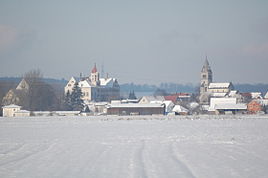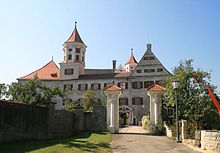Brenz on the Brenz
|
Brenz on the Brenz
Municipality Sontheim
|
|
|---|---|
| Coordinates: 48 ° 33 ′ 42 ″ N , 10 ° 17 ′ 45 ″ E | |
| Height : | 446 m |
| Residents : | 1040 |
| Incorporation : | 1st January 1974 |
| Postal code : | 89567 |
| Area code : | 07325 |
|
Brenz from the southeast
|
|
Brenz is a district of Sontheim an der Brenz in the Heidenheim district in Baden-Württemberg .
geography
Brenz is located directly on the river of the same name and at the transition from the Swabian Alb to the Danube Valley .
history
On the dominant Kirchberg in Brenz was in the 2nd / 3rd. Century AD a villa rustica ; In addition, finds of parts of monumental buildings indicate further Roman settlement. Brenz is located on the former Roman road to Heidenheim (Latin Aquileia ).
After the retreat of the Romans from around 260 AD due to the ongoing Alemannic storms , they used the strategically located Brenz Kirchberg as a settlement. Excavations in the 1960s brought to light the remains of an early Christian wooden church that stood there around 650, including an Alemannic burial ground. This church is likely to be the oldest sacred building in the Brenz Valley, and it can be assumed that the Christianization of the region was promoted from Brenz in addition to the lively settlement activity ( Sontheim , Bächingen , Bergenweiler ) . Around 680 the wooden church was replaced by a first stone building.
The place was first mentioned in a document at the beginning of the High Middle Ages: in 875 King Ludwig II left the Capella ad Prenza to the Faurndau monastery . A few years later the Brenz church property came to the St. Gallen monastery . After numerous new buildings and renovations, today's Gallus Church, a jewel of Romanesque architecture , was built around 1200 .
The rule of Brenz was in the High Middle Ages with a lower nobility named after the place, whose members were repeatedly recorded in the 12th and 13th centuries. A grave slab of Sebolt von Brenz from around 1190, which identifies him as a crusader , has been preserved in the Gallus Church . Around 1250 a family of Hohenstaufen ministers, the Lords of Güssenberg (called Gussen ), sat at Brenz Castle . As these fell into robbery , it was destroyed in 1340, but rebuilt soon afterwards.
During the Schmalkaldic War , Emperor Charles V moved into quarters at the Güssian Castle in Brenz in 1546. The casts became increasingly impoverished and had to pledge their rule of Brenz to the Duchy of Württemberg and finally sell it entirely in 1613. Württemberg immediately introduced the Reformation (1615).
In 1617 Duke Julius Friedrich von Württemberg received the dominions of Brenz and Weiltingen as an allowance; He was the founder of the short-lived Württemberg-Weiltingen line, which Brenz Castle used as a temporary secondary residence. After Brenz Castle was destroyed in 1634 after the Battle of Nördlingen , Duke Friedrich Ferdinand had it rebuilt in the Renaissance style from 1672 .
After the Württemberg-Weiltingen line died out, Brenz fell back to the main line of the ducal house. Duke Eberhard Ludwig gave it to his mistress Wilhelmine von Grävenitz in 1721 . After falling out of favor, she had to leave Württemberg and her estates. Brenz Castle has remained largely unused since then; a branch of the von Racknitz family lived there briefly .
In the 19th century the community acquired the castle and housed administration and school in it; In 1906, the oldest local museum in Württemberg was founded there.
The independence of Brenz ended on January 1st 1974 when it was incorporated into the larger Sontheim, which was once founded by Brenz.
Culture and sights
Museums
The oldest local museum in Württemberg is located in the castle.
Buildings
- Gallus Church : The late Romanesque column basilica is one of the most important buildings in art history in the Heidenheim district and occupies a special position in the state of Baden-Württemberg. During the fundamental renovation in 1964/66, efforts were made to bring the three-aisled basilica back to its best advantage as faithfully as possible by removing Gothic, Baroque and Neo-Gothic changes. In addition, Romanesque paintings were exposed in the apse .
- Castle: Particularly noteworthy are the arcade-decorated inner courtyard and the knight's hall , where concerts are regularly held.
- Market square: A remarkable ensemble of the historic facades of the Gallus Church, rectory, Schlössle (today Gasthof Hirsch ), Gasthaus Krone and the former administrative building.
Sons and daughters of the church
- Andreas Althamer (* Brenz around 1500), reformer and humanist
- Johann Friedrich von Klemm (1793–1858), politician and senior bailiff in Tettnang, Ellwangen and Esslingen
- Franz Josef Dannecker (1927–1992), politician and lawyer
Individual evidence
- ^ Federal Statistical Office (ed.): Historical municipality directory for the Federal Republic of Germany. Name, border and key number changes in municipalities, counties and administrative districts from May 27, 1970 to December 31, 1982 . W. Kohlhammer, Stuttgart / Mainz 1983, ISBN 3-17-003263-1 , p. 470 .
- ↑ http://www.sontheim-brenz.de/schloss-brenz/heimatmuseum
literature
- Cichy, Bodo: The Church of Brenz, 1991 (3rd edition).
- Municipality of Sontheim an der Brenz (ed.): Heimatbuch Sontheim an der Brenz, 1984.




